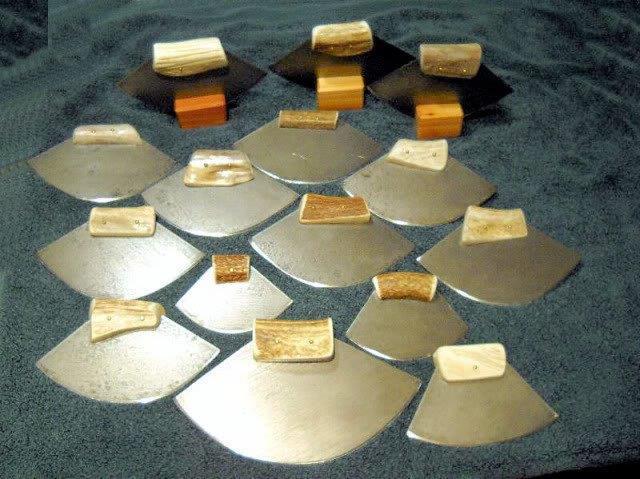Disclaimer-Due to some unforeseen equipment and life problems I do no currently have any ulu in stock. There are some folks on here that have been waiting for me to make some but I simply have not yet but have been gearing up again to make up a batch of them.


Here are some grainy but representative pictures of my ulu. The first one (4 of them) are all Moose but it shows the different sizes pretty well. The second one has a lot of different ones. Keep in mind that all of these have been sold already. My ulu all come with one of the little cedar standing blocks as shown in the pictures.
I make the blades for the ulu from handsaws from the 1880's-1890's as it is about the best high carbon steel ever made. I cut them cold and grind them cold to not mess up the temper. When I grind, if they don't spark just right I toss them away. I bed the blade into the handle, usually antler, with epoxy and then pin them with brass pins. They are built to be used but most wind up on a shelf on display.
My personal preference for handle material is Moose. It's tougher for me to work but it seems to be more durable than others and has a rougher surface that is easier to hang onto. Second is Whitetail as it is quite similar to Moose. Caribou tends to be pretty smooth but is very nice looking and traditional. Elk is good and tends to run larger than the others, so if you have large hands it might be a good choice. I put a lot of work into shaping and polishing the handles. With use they tend to loose the high polish but not the durability.
I use the knife bevel for skinning and other general use. If you are going to use the ulu for fleshing, the chisel bevel may work better for you and is a little faster to re-sharpen. Fleshing with an ulu has traditionally been done over the knee. There are some pretty decent fleshing videos using an ulu on YouTube. There's even one on there "Ray Heidel-Ulu Maker"...that's me!
Moosetrot




![[Linked Image]](http://sniperstrappingplace.com/greysig.png)








![[Linked Image]](http://banners.wunderground.com/weathersticker/miniDial_both/language/www/US/UT/Magna.gif)
